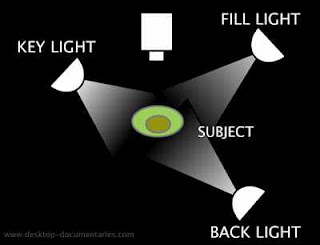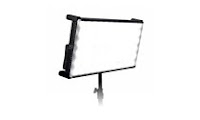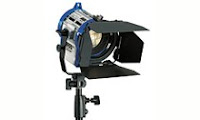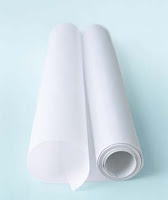 By Dan Parkes (Director)
By Dan Parkes (Director)'What debate?' you may ask. And I agree. There isn't one. In my opinion, No DoP (Director of Photography) = No film. However, when I released "
Tip #42: Simple and effective lighting equipment" (
http://bit.ly/bwtl2w) the number of hits on the blog skyrocketed. Not only that, but I suddenly started receiving increasingly unpleasant comments and e-mails including those recommending me to "
keep it to yourself," saying that I think of myself as "
God" and that I have been "
disloyal," "
unappreciative" and even '
abusive,' making a "
huge public gaff," a "
massive fool" with a "
high bizarre value". Ultimately, it has been labeled the "
Ambleton Delight Debacle" by none other than blogger Ben Blaine, called a "
DP bashing" by others and a widespread call for me to
delete the blog and publicly
apologise.
So what was the source of all of this offence? Was it the 'magic' reference at the beginning? The blog was about only the kit (part two being about the techniques:
http://bit.ly/ag5NKO) so was there something
incorrect in the list? Well yes, I wrote "diffuse" instead of diffusion. And somebody pointed out I could have included "black foil, colour meters and light meters". But still not enough to justify the vitriol, surely?
 Brilliant cinematographer Jack Cardiff
Brilliant cinematographer Jack Cardiff I was determined to track it down and found it led to a post on cinematography.com in which a certain Karel Bata created a thread entitled "
Blog on why you don't always need a DP on a feature -Unbelievable". This had a link to tip #42, but no normal link -it had been cleverly renamed "
NoDphere". The thread of course resoundly condemns the alleged 'no DP' blog and it is finally all dismissed as not even worthy of attention and goes on to discuss the more important issues of using the terms "camerawoman" and "cinematographer".
So was there really no DoP on the feature
Ambleton Delight? Far from it! As the blog and elsewhere clearly states, we had a
dedicated DoP for all the major scenes, with supplementary material being DPed by me with assistance from the camera team and assistant director -two of us are jobbing lighting cameraman, so this was never going to be a huge issue. I believe it is essential to 'paint with light' on a film -as a child the very first word I ever uttered was not "mummy" but according to my father I said 'light,' so it was clearly important from a young age! Not to mention the initials of my name happen to spell "D.P."...
 British DP Roger Deakins
British DP Roger Deakins Is the fact that there was
more than one DoP on the film the issue? A high level example of how this should not be an issue is the fact that Stephen Daldry's recent film "The Reader" had two DPs (Roger Deakins and Chris Menges) due to scheduling. Of course we are in no way comparing ourselves to such well respected professionals, but it shows that continuity can be maintained with more than one DP.
So may be the issue is that the director, in this case myself, was also DPing? Is this normal or evidence of an ego trip? Again, without ever wanting to compare myself to such luminaries of the film world but rather wanting to be inspired by them, here is a list of directors who have or continue to
simultaneously direct and DP:
- Steven Soderbergh (pseudonym Peter Andrews)
- Peter Hyams
- Robert Rodriguez
- Doug Liman
- David Lynch
- Nicolas Roeg
- Lars von Trier
- Quentin Tarantino (in Death Proof)
- Christopher Doyle (in A Way with Words)
- Josef von Sternberg
- Rainer Werner Fassbinder
- Gaspar Noé
- Ermanno Olmi
- Mario Bava
- Philippe Grandrieux
- Shinya Tsukamoto
 Director/Cinematographer Robert Rodriguez
Director/Cinematographer Robert Rodriguez Stanley Kubrick also, according to rumour, DPed his films, with the credited DP complaining he ended up just the gaffer. Other directors such as James Cameron, Ridley Scott, Steven Speilberg and John Cassavetes have also been known to camera operate. There is of course the issue of being
distracted from their role as director. However, if this causes such an outcry, one wonders why the acting community is not more vociferous when directors also act in their films, as surely this is an equal if not worse crime. But few seem to criticise Clint Eastwood or Woody Allen for also acting in their films, attribute it to ego or feel that by doing so reduces their efficiency as a director. Why is DPing any different?
 Director James Cameron with his 3D camera
Director James Cameron with his 3D camera My personal take on this is that I often end up lighting and camera operating on small interview and corporate shoots and I enjoy it immensely. However for a feature I would
much rather have a dedicated DoP so I do not compromise what is expected of a director on set -especially when it comes to working with actors. I also believe other DPs are more likely to do a better job!
In the case of
Ambleton Delight we had
extensive rehearsals with the actors so there was not a huge amount of ground to cover on set. Also the scenes in which I was both director and DP were much smaller -often 'two-handers'. And in some cases the lighting design had already been previously set by the dedicated DoP and so was just a case of
replicating it. And the final product speaks for itself. There is
no obvious differences between shots lit by the dedicated DP and when I was DPing. I challenge anyone to be able to point it out.
 DP Christopher Doyle
DP Christopher Doyle
But to finish, here is a most interesting point: This was tip #42. Previously we have discussed location scouting, production design, script writing, catering and many other departments. Professionals in each respective area could well have taken equal offence because we did not have dedicated crew for the entire shoot or possibly overlooked some minor detail in their role. But we have only received support and encouragement. However, as soon as we list some lighting equipment and mention there was only a dedicated DoP for key scenes we are
inundated with complaints. It makes you wonder if that 'magicians code' quip was somehow correct after all. Are DPs really the
"luvvies" of the crew department, needing constant reassuring of their necessity on set and determined to keep their profession a 'dark art' to ensure this? I would never have thought so, but it seems such a shame that some are intent on giving that impression.
Some useful links:
http://www.cinematography.com/index.php?showtopic=46963http://www.stevensoderbergh.net/articles/2002/cinematographer.phphttp://mubi.com/topics/3767Cinematography For Directors (book):
http://galileo.dv.com/inreview/article/87446Great Director-DoP relationships:
http://en.wikipedia.org/wiki/List_of_film_director_and_cinematographer_collaborationsAlso:
http://www.dailyfilmdose.com/2007/06/great-cinematographer-director.htmlCasting cinematographers:
http://www.moviemaker.com/editing/article/casting_your_cinematographer_3317/British DP Roger Deakins website forum:
http://www.deakinsonline.com/forum2/
 By Itsuka Yamasaki (Producer)
By Itsuka Yamasaki (Producer)





































